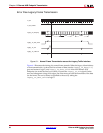
Ethernet AVB Endpoint User Guide www.xilinx.com 61
UG492 July 23, 2010
Tx Arbiter
Tx Arbiter
Overview
As illustrated in Figure 5-1, data for transmission over an AVB network can be obtained
from three types of sources:
1. AV Tr affic . For transmission from the AV Traffic I/F of the core.
2. Precise Timing Protocol (PTP) Packets. Initiated by the software drivers using the
dedicated hardware “Tx PTP Packet Buffer.”
3. Legacy Traffic. For transmission from the Legacy Traffic I/F of the core.
The transmitter (Tx) arbiter selects from these three sources in the following manner.
• If there is AV packet available and the programmed AV bandwidth limitation is not
exceeded, then the AV packet is transmitted
• otherwise the Tx arbiter checks to see if there are any PTP packets to be transmitted
• otherwise if there is an available legacy packet then this will be transmitted.
The Ethernet AVB Endpoint core contains configuration registers to set up the percentage
of available Ethernet bandwidth reserved for AV traffic. To comply with the IEEE P802.1
Qav specification these should not be configured to exceed 75%. The arbiter then polices
this bandwidth restriction for the AV traffic and ensures that on average, it is never
exceeded. Consequently, despite the AV traffic having a higher priority than the legacy
traffic, there is always remaining bandwidth available to schedule legacy traffic.
The relevant configuration registers for programming the bandwidth percentage
dedicated to AV traffic are defined in Chapter 10, “Configuration and Status” and are:
• “Tx Arbiter Send Slope Control Register”
• “Tx Arbiter Idle Slope Control Register”
These registers are defaulted to values which dedicate up to 75% of the overall bandwidth
to the AV traffic. This is the maximum legal percentage that will be defined in the
IEEE802.1 AVB standards.
In many implementations, it may be unnecessary to change these register values. Correct
use of the av_tx_done signal, as defined in “Tx AV Traffic I/F,” will allow the Tx Arbiter
to share the bandwidth allocation efficiently between the AV and Legacy sources (even in
the situations where the AV traffic requires less than 75% of the overall bandwidth).
However, for the cases that require less than 75% of the overall bandwidth, careful
configuration can result in a smoother (less bursty) transmission of the AV traffic, which
should prevent frame bunching across the AVB network.
Credit Based Traffic Shaping Algorithm
To enforce the bandwidth policing of the AV Traffic, a credit-based shaper algorithm has
been implemented in the Ethernet AVB Endpoint core. Figure 6-4 illustrates the basic
operation of the algorithm and indicates how the Tx Arbiter decides which Ethernet frame
to transmit.


















